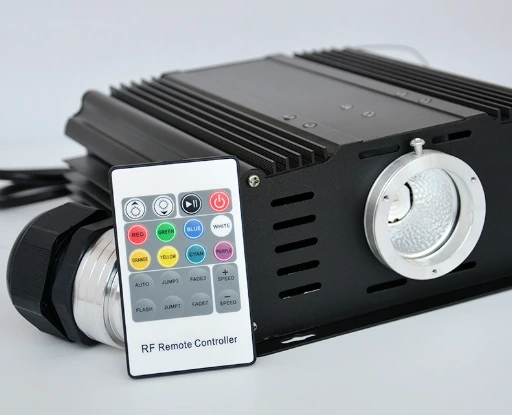Fiber Optical Light Sources for Network Reliability
Explore network reliability with our Fiber Optical Light Sources. Accurate wavelength generation and signal quality testing for dependable optical networks.

The Fiber Optical Light Source is an indispensable tool for testing and verifying fiber optic cables. It generates stable and consistent light signals for testing purposes, ensuring accurate measurements. This versatile device finds extensive application in various scenarios, making it an essential asset for network maintenance, installation, and troubleshooting tasks.
Key Features of Fiber Optical Test fiber optical light sources
- Multiple Wavelength Support: Our Fiber Optical Light Source supports multiple wavelengths commonly used in fiber optic networks, including 1310nm and 1550nm. This versatile wavelength support allows technicians to adapt to different network configurations and testing requirements. It’s ideal for use in telecommunications, data centers, and enterprise networks.
- Modulation and Continuous Wave Modes: The device offers both modulation and continuous wave (CW) modes. Modulation is particularly useful for identifying specific fibers and optimizing testing conditions. The CW mode is ideal for tasks requiring a continuous light signal, such as fiber identification, optical loss testing, and network certification.
- User-Friendly Interface: With an intuitive and user-friendly interface, the Fiber Optical Light Source simplifies operation. Technicians of varying expertise levels can easily navigate its controls. The clear and informative display provides real-time feedback, allowing users to monitor and adjust parameters effortlessly.
- Durable Construction: Built to withstand the rigors of fieldwork and laboratory environments, our Fiber Optical Light Source boasts a rugged and durable construction. Its robust design ensures long-lasting performance, even in challenging conditions. This durability contributes to the tool’s reliability and longevity.
Uses of Fiber Optical Test fiber optical light sources
- Optical Loss Testing: The Fiber Optical Light Source is used in conjunction with an Optical Power Meter to measure optical loss in fiber optic cables. It helps ensure that optical signal strength meets specified standards and identifies potential issues within the network.
- Fiber Identification: By emitting light signals into optical fibers, the device aids in the identification and labeling of individual fibers in complex fiber optic networks. This is especially valuable for large-scale deployments and data centers.
- Certification Testing: It plays a crucial role in network certification processes, ensuring that newly installed fiber optic cables meet industry standards for performance and reliability.
- Troubleshooting: During network troubleshooting, the Fiber Optical Light Source assists technicians in pinpointing faults, detecting breaks or bends in fibers, and verifying proper connections.
- Optical Fiber Characterization: It contributes to the characterization of optical fibers, providing data on fiber characteristics, such as attenuation and dispersion.
Case Studies of Fiber optical light sources
Optimizing Data Center Connectivity
- Problem: A data center experienced intermittent connectivity issues and reduced data transfer rates.
- Solution: Fiber Optical Light Sources were employed to provide stable and accurate optical signals. By ensuring precise signal quality and compatibility with data center equipment, the data center achieved improved connectivity and enhanced data transfer rates.
Enhancing Telecommunication Network Reliability
- Problem: A telecommunications network suffered from frequent disruptions and inconsistent connections.
- Solution: Fiber Optical Light Sources were utilized to emit reliable optical signals through the network. They helped identify signal losses attributed to damaged fiber connections. Subsequent repairs and maintenance led to the restoration of network reliability and reduced connection issues.
Optimizing Medical Imaging Systems
- Problem: A medical imaging system exhibited image artifacts, compromising diagnostic accuracy.
- Solution: Fiber Optical Light Sources were employed to assess and enhance signal quality. The light sources identified and rectified signal quality issues, resulting in improved image clarity and more accurate medical diagnoses.
Improving Enterprise Network Performance
- Problem: A corporate network suffered from slow data transfer rates, affecting productivity.
- Solution: Fiber Optical Light Sources were used to generate high-quality optical signals. They revealed signal attenuation issues within the network infrastructure. Adjustments, including signal boosters and optimized fiber connections, led to improved data transfer rates and enhanced network performance.
Stabilizing Research Laboratory Signals
- Problem: A research laboratory required stable and precise optical signals for experiments.
- Solution: Fiber Optical Light Sources were employed to ensure the generation of stable and accurate optical signals. This contributed to research accuracy and consistency by providing a dependable signal source for experiments.
Enhancing ISP Network Reliability
- Problem: An internet service provider (ISP) faced frequent network outages and connectivity disruptions.
- Solution: Fiber Optical Light Sources were used to assess the signal quality throughout the ISP’s network infrastructure. Signal losses and quality issues were identified. Network upgrades and improvements were implemented based on the findings, resulting in enhanced network reliability and reduced outages.